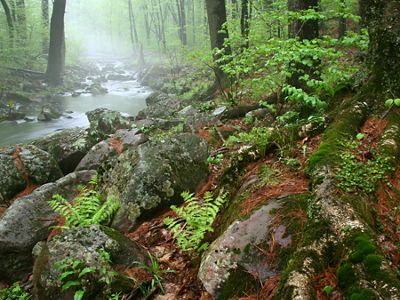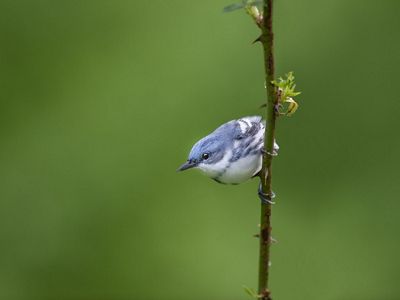Baraboo Hills: A Haven for Birds in a Time of Change
Ornithologist Mike Mossman talks with us about his research and what it is telling him about birds, the Baraboo Hills and climate change.
Keep in Touch!
Sign up for our monthly Nature News email.
The Baraboo Hills in south central Wisconsin are a sanctuary for birds and other wildlife in a landscape largely dominated by agriculture.
More than half (about 135) of the 226 species of birds that breed in Wisconsin use the Baraboo Hills as a nesting area, and as many as 250 different species either breed in the Hills or pass through during migration.
While the forests of the Baraboo Hills are in relatively good condition, we are losing oak trees, putting the birds, insects and other wildlife that depend on them at risk. Climate change will further exacerbate this situation by reducing forest diversity, giving birds and other species fewer options to disperse and shift as conditions change.
The Nature Conservancy has worked to protect the vast forests in the Baraboo Hills for more than 55 years. In 2014, we began to restore the oak forests at our Baxter’s Hollow and Hemlock Draw preserves, using thinning and prescribed fire to set the stage for acorns to germinate and take root and for oak seedlings to have plenty of light to compete well.

Mike Mossman is an ornithologist who has spent more than 45 years studying birds and their habitats in the Baraboo Hills. We checked in with Mike to learn more about his research and what it is telling him about birds, the Baraboo Hills and climate change.
TNC: Why are the Baraboo Hills such a great place for birds?
Mossman: The diverse mix of habitats—ranging from cool stream gorges with relict hemlock stands to dry rocky glades with stunted oak and hickory trees—is one reason the Hills are a great place for birds. There is a large expanse of forest with minimal fragmentation, which provides a lot of deep, interior forest, which is important for breeding and nesting. The active, science-based management provided by TNC and other partners is also critical.
TNC: Why are oak trees particularly important for birds?
Mossman: Oaks are long-lived trees, and their acorns are an important food source for birds like the red-headed woodpecker and other wildlife. Their size and semi-open canopies provide many different types of opportunities for birds to nest and feed. White oaks, especially, have very high insect diversity and are leafing out just as hungry warblers and other migratory birds are arriving in the Hills from their wintering grounds in the tropics.

TNC: Can you tell us about the bird surveys you’ve been doing in the Hills?
Mossman: I’ve been doing bird surveys in the Hills since 1976, starting with the stream gorges, to learn which areas birds were using for breeding and what they needed to breed successfully. Since then, I have continued to survey these same areas, looking at population changes and responses to habitat change and land management.
In 2012, I began more intensive field studies of breeding birds on TNC properties in conjunction with forest measurements TNC was taking on most of its forest lands in the Baraboo Hills. They measured forest structure and composition, and I and my crew counted birds in these same areas to relate the abundance of various bird species to the nature of the forest habitat. My team and TNC set our survey areas up in a collaborative way so we could repeat our surveys in the future, and, thus, monitor the effects of TNC’s management activities on the bird communities.
TNC: What have you learned about birds in the Hills so far?
Mossman: The long-term monitoring has indicated that some species are in trouble, for example birds that are typically found farther north in Wisconsin including the Canada and magnolia warblers. Other species like the American redstart are increasing.
TNC: Have those surveys told you anything so far about TNC’s oak restoration work?
Mossman: It’s too early to say anything conclusive yet about the work in the Baraboo Hills. In other places, we have seen that prescribed fire is a dynamic process with effects that vary over years of management and across the forest landscape. For example, Acadian flycatchers, which prefer semi-open understory under a complete tree canopy, may benefit when a dense forest understory is opened by prescribed fire, but be excluded from sites as fire eventually opens the canopy more.
Quote: Mike Mossman
Climate change is already impacting habitats in the Baraboo Hills . . . So, we should be concerned, but at the same time, places like the Baraboo Hills provide the most hope for birds and other species as the climate changes.
TNC: What impacts might climate change have on the Hills and the birds that depend on them?
Mossman: Climate change is already impacting habitats in the Baraboo Hills, especially the stream gorges. For example, the flooding and tree blow downs caused by major storms that started in the 1980s have changed the stream gorges, especially Baxter’s Hollow and Pine Hollow, resulting in a more open canopy, a more disturbed understory, and the decline of some of the northern forest species like hemlock that are important for certain bird species.
So, we should be concerned, but at the same time, places like the Baraboo Hills provide the most hope for birds and other species as the climate changes. They do so well here in the first place because there is not only a large expanse of forest, but within the forest there are all these little niches they can use—from the forest floor to the canopy and then across the landscape from stream gorges to ridge tops. There are not sharp lines and interruptions between these habitats, so plants and animals can migrate across them.



